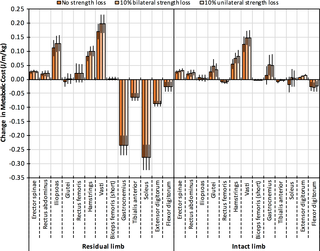PLOS ONE ( IF 2.9 ) Pub Date : 2018-01-12 , DOI: 10.1371/journal.pone.0191310 Elizabeth Russell Esposito , Ross H. Miller

|
Recent studies on relatively young and fit individuals with limb loss suggest that maintaining muscle strength after limb loss may mitigate the high metabolic cost of walking typically seen in the larger general limb loss population. However, these data are cross-sectional and the muscle strength prior to limb loss is unknown, and it is therefore difficult to draw causal inferences on changes in strength and gait energetics. Here we used musculoskeletal modeling and optimal control simulations to perform a longitudinal study (25 virtual “subjects”) of the metabolic cost of walking pre- and post-limb loss (unilateral transtibial). Simulations of walking were first performed pre-limb loss on a model with two intact biological legs, then post-limb loss on a model with a unilateral transtibial prosthesis, with a cost function that minimized the weighted sum of gait deviations plus metabolic cost. Metabolic costs were compared pre- vs. post-limb loss, with systematic modifications to the muscle strength and prosthesis type (passive, powered) in the post-limb loss model. The metabolic cost prior to limb loss was 3.44±0.13 J/m/kg. After limb loss, with a passive prosthesis the metabolic cost did not increase above the pre-limb loss cost if pre-limb loss muscle strength was maintained (mean -0.6%, p = 0.17, d = 0.17). With 10% strength loss the metabolic cost with the passive prosthesis increased (mean +5.9%, p < 0.001, d = 1.61). With a powered prosthesis, the metabolic cost was at or below the pre-limb loss cost for all subjects with strength losses of 10% and 20%, but increased for all subjects with strength loss of 30% (mean +5.9%, p < 0.001, d = 1.59). The results suggest that maintaining muscle strength may prevent an increase in the metabolic cost of walking following unilateral transtibial limb loss, and that a gait with minimal deviations can be achieved when muscle strength is sufficiently high, even when using a passive prosthesis.
中文翻译:

在胫骨四肢缺失后的模拟步行中,维持肌肉力量可以维持正常的代谢成本
最近对肢体缺失的相对年轻和健康个体的研究表明,肢体缺失后保持肌肉力量可能减轻通常在较大的一般肢体缺失人群中所见的步行的新陈代谢成本。但是,这些数据是横断面的,肢体丧失之前的肌肉力量尚不清楚,因此很难得出关于力量和步态能量变化的因果推断。在这里,我们使用肌肉骨骼模型和最佳控制模拟对行走前肢和后肢丧失(单侧胫骨)的代谢成本进行了纵向研究(25个虚拟“受试者”)。首先在具有两条完整生物腿的模型上进行前肢丧失,然后在具有单侧胫骨假体的模型上进行后肢丧失模拟,具有最小化步态偏差的加权总和加上新陈代谢成本的成本函数。比较了肢体损失前和肢体损失后的代谢成本,并在肢体损失模型中对肌肉力量和假体类型(被动,动力)进行了系统性修改。肢体丧失之前的代谢成本为3.44±0.13 J / m / kg。肢体丧失后,如果维持了肢体前丧失肌肉的力量,则在被动假体的情况下,代谢成本不会增加到肢体前丧失成本以上(平均值为-0.6%,p = 0.17,d = 0.17)。力量损失10%时,被动假体的代谢成本增加(平均值+ 5.9%,p <0.001,d = 1.61)。使用动力假体时,对于力量损失为10%和20%的所有受试者,其代谢成本均等于或低于肢体运动前的损失成本,但对于所有力量丧失为30%的受试者,其代谢成本均升高(均值+ 5.9%,p < 0.001,d= 1.59)。结果表明,保持肌肉力量可能会阻止单侧经胫骨肢体丢失后步行的代谢成本增加,并且当肌肉力量足够高时,即使使用被动假体,步态也可以达到最小偏差。











































 京公网安备 11010802027423号
京公网安备 11010802027423号